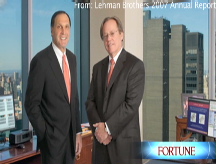Goldman Sachs does it again
Wall Street powerhouse books $2.1 billion profit, topping forecasts and proving yet again that it is largely avoiding credit crunch pain.
NEW YORK (CNNMoney.com) -- Goldman Sachs reported a $2.1 billion quarterly profit Tuesday, beating forecasts and showing once again that it has largely avoided the credit crunch that has hurt many of its Wall Street rivals.
The New York City-based investment bank said net earnings for its second quarter, which ended in May, came in at $4.58 per share. While that was 11% lower than the profit of $2.3 billion, or $4.93 per share, that Goldman reported a year ago, it still handily beat Wall Street's estimate of $3.42 per share.
Goldman also said revenue fell 7.5% to $9.42 billion during the quarter. But that also easily topped the consensus forecast of $8.74 billion.
The news, however, appeared to not excite investors all that much as Goldman Sachs (GS, Fortune 500) shares were flat in midday trade.
"It was a very, very good quarter," said Helena Ocampo, an equity analyst at Sentinel Investments in Montpelier, Vermont, which manages $5.5 billion and holds shares of Goldman. "You do see a little bit of weakness, however, they are clearly the leader."
One of those areas of softness was in investment banking, one of the cornerstones of Goldman's business, which saw its revenues fall 2% during the quarter. Weighing on performance was a sharp decline in leveraged loan activity which was offset by a surge in equity underwriting, as more and more companies looked to raise capital during the quarter.
One of the hardest-hit segments of Goldman's business was its fixed income, currency and commodities business. Profits tumbled 29% from a year earlier. The company blamed part of that decline on a $500 million loss related to hedges.
Offsetting the trouble spots were higher revenue in Goldman's asset management and its securities services divisions, which got a lift from its prime brokerage business that services hedge fund clients.
During the quarter, Goldman Sachs took steps to pare back some of the riskiest loans on its balance sheet. Its leveraged loan exposure was $14 billion, down from $52 billion at the end of last year's third quarter, said David Viniar, Goldman Sachs' chief financial officer, in a conference call with analysts.
The company also reduced its residential and commercial real estate holdings by $4 billion and $2.4 billion respectively, Viniar said.
"We have been through a pretty tough environment," said Viniar. "Being a little smaller we thought was a sensible thing."
Viniar also revealed that Goldman's Tier 1 capital ratio remained at 10.8%. This quarter marks the first time that Wall Street's investment banks have disclosed this key metric, which is widely considered to be a measure of a bank's ability to absorb losses. A Tier 1 capital ratio of above 8% is generally considered a good sign for financial institutions.
Goldman's impressive results come on the heels of a tough loss at crosstown rival Lehman Brothers (MS, Fortune 500) and at a particularly difficult time for Wall Street in general. On Monday, Lehman confirmed its previously announced $2.8 billion second-quarter loss while its management sought to ease concerns that the firm was on the brink of a Bear Stearns-like collapse.
Morgan Stanley (MS, Fortune 500) is expected to follow that up by reporting Wednesday morning that its second-quarter profit plunged nearly 60% from a year earlier.
What's more, there have been fears that the old way of doing business on Wall Street is nearing extinction - investment banks are relying less on leverage to boost their returns and have been cutting jobs to deal with the credit crisis.
Wall Street firms also now face the threat of greater regulatory oversight after the Federal Reserve decided to open its discount lending window to prevent failure among investment banks. ![]()


